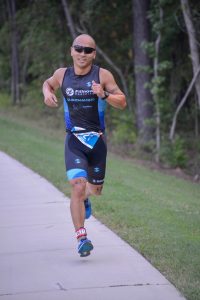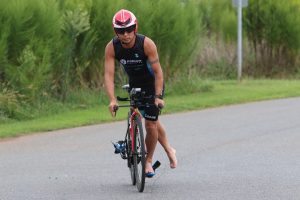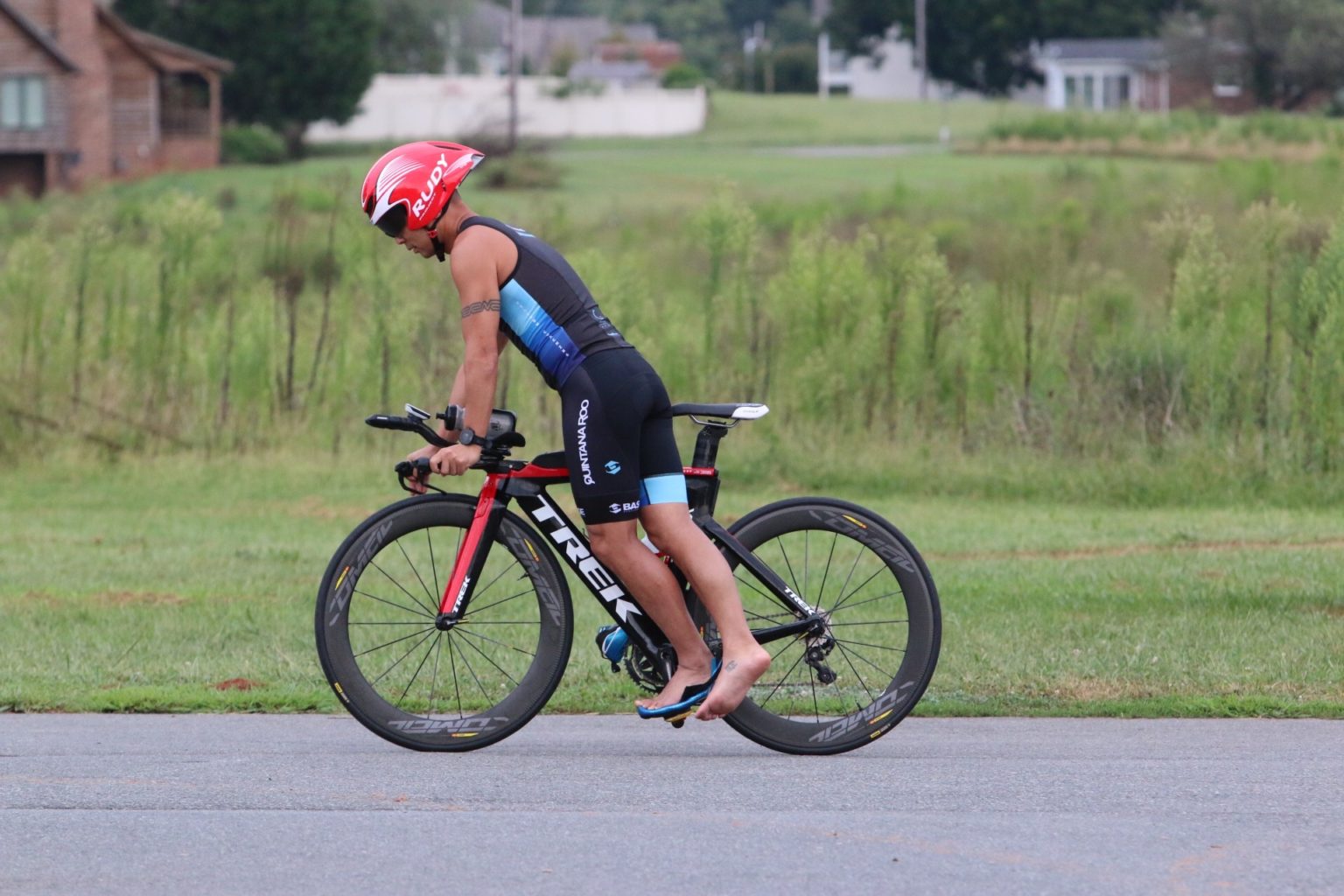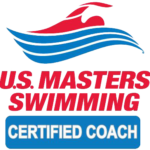by Theoden Janes
Do you ever feel like, on some level, you’ve plateaued as a triathlete? That you repeatedly do everything your coach asks of you, that you crush your training, that you execute to the best of your ability on race day, and yet you still can’t seem to quite hit that big stretch goal you’ve been after forever?
Well, maybe you’re looking for those last couple/few minutes in the wrong place.
The key to a breakthrough, for many an age-grouper, could very well lie in transition. You know, that part of the race most of us only give any serious thought to — or get any practice at — on race days.
I’m not here to tell you that you need to work on transitions as often as you work on swimming, biking and running (to be completely honest, I don’t practice them at all), but I do routinely stress to other triathletes how critically important it is to remember that T1 and T2 ARE PART OF THE RACE. And racing through transition quickly and efficiently can make an alarming difference.
I’ll give you an example: A couple of years ago, I did a sprint triathlon in which the sum total of my three primary splits was slower than that of the guys who finished fourth and fifth in my age group — yet I ended up on the podium. Here’s another example: In an Ironman event with two- or three-thousand athletes, shaving just 30 seconds off of both your T1 and T2 times can move you a mid-packer up dozens of places in the results, all other things being equal.
As an added bonus, I take great pride in consistently having transition times that are in the top 2 or 3 percent of all athletes; I mean, that’s just never going to happen for me in the swim, bike or run.

So, how do you shave off chunks of time in transition? Obviously, you can find pages and pages of guides to better transitions on the Internet, and my aim is not to be exhaustive or even extensive in covering the topic — but these are the key points I hit on whenever someone asks me how I’ve been able to master triathlon’s fourth discipline.
1. BE A MINIMALIST, PART I. For me, it’s simple: Bike on the rack, helmet on the handlebars; bike shoes and bike fuel up front; running shoes in the back, next to or underneath (but not on top of) my running hat, my sunglasses, my race belt and my gels. Maybe a small bottle of water next to the running shoes on a warmer day. That’s it. Get everything else out of there. (At smaller races, I’ll put my gear bag against the transition wall nearest my bike; at events where doing that isn’t allowed, like an Ironman, I’ll crush it down and stick it in the provided gear bag and drop it at the swim start.) Anything else you lay down on your transition towel “just in case” can create confusion, or add to the feeling of being overwhelmed, and what you don’t want is to feel confused or overwhelmed in transition.
2. DO IT WHILE YOU’RE MOVING, PART I. As soon as you step out of the water, get the goggles and swim cap off of your head. You’re done swimming — you don’t need ’em on anymore. Then, if it’s a wetsuit race, immediately reach behind your neck or back to grab that string and work down that zipper. Get your arms out so that the top half is peeled to your waist as fast as possible. Whether there are strippers or not, this will speed up the process of getting out of that neoprene prison. Oh, and speaking of wetsuits, before the race, you should have sprayed a ton of body glide on the bottom of the legs

3. MAKE A FEW EQUIPMENT UPGRADES? Invest a few dollars in elastic laces (e.g. Yankz or Easy Laces) that allow you to slip into your running shoes lightning-quick. A couple of other things to consider next time you’re looking to treat yourself to new gear, if you don’t already have them: 1) triathlon-specific bike shoes that have just one strap (because again, every second counts, and they do go on faster than shoes with multiple straps); 2) an aero helmet with a visor, which eliminates the need for sunglasses on the bike and makes getting out of T1 even easier. And I know, I know — triathlon keeps sucking up all of my money, too.
4. LEARN TO FLY. The flying dismount is considered an advanced technique used by more-experienced triathletes, but it’s really a lot less-difficult to pull off than you might think. About a quarter-mile from the bike finish, without clipping out, I slip out of my bike shoes (without looking down) one at a time and then continue pedaling with my feet on top of my shoes. As you roll up to the dismount line, I stand up in the saddle, swing my right leg over so it’s on the left side of my bike, and hop off right at the line, straight into a run (your bike shoes stay clipped in). You obviously can YouTube this. But trust me: If you’re coordinated enough to clip in and clip out of your pedals, you’re coordinated enough to do a flying dismount. I learned how to do it in about three minutes. It can save several seconds, it’s way easier to run barefoot, and you look like a pro next to everyone else who stops at the line to get clipped out. As for the flying mount? That is an advanced technique used by only the most-experienced triathletes. I’m still working up the courage.
5. BE A MINIMALIST, PART II. OK, so I realize these next tips aren’t going to be for everybody, but they are for me (and they do help me get out of transition faster), so they’re options that are at least worth exploring. First, I don’t wear bike gloves. It’s a personal preference, but that’s a savings of several more seconds right there. Second, unless I’m doing a full Ironman, I don’t wear socks. I cover my feet and the upper insides of my bike and running shoes with Body Glide and/or Tri Slide, and I’m lucky to rarely suffer blisters. If you frequently do, by all means, wear socks (but leave them rolled up inside out so they go on your wet/sandy feet more easily). But this definitely is a time-saver — and since I am just as comfortable without them, a no-brainer. Another no-brainer: If you plan to experiment with the no-socks thing, do it in training, not on race day.
6. DO IT WHILE YOU’RE MOVING, PART II. Remember I mentioned that I don’t put anything on top of my running shoes? That’s because once my bike is racked and my helmet is on the ground, all I do is slip on my shoes and then take two hands and grab my hat, glasses, belt and gels. It might sound like a lot to fumble with; it’s really not. As I bolt out onto the run course, I throw on my hat first, then the glasses, then use two hands for the belt. I typically carry my gels in my hand. But the point is this: There’s no reason to stand around putting that stuff on when you can do it while you’re running.
Finally, once you’ve got all this other stuff on lock, my No. 1 rule — although here it’s No. 7 — is GO AS FAST AS YOU POSSIBLY CAN. When I hit that timing pad after getting out of the water, I start hearing a clock tick in my head, and the only way to get it to stop is to cross the pad as I set out on the bike. Same in T2. The whole time, I’m thinking, How fast can I get out of here? If I come in and there’s another athlete already at their bike, my goal is to be heading for the exit before they are. I realize that there’s a risk in going TOO fast — that rushing could lead to some sort of mistake that costs you down the line — but the key here, again, is just to really be mindful that transitions are very much part of the race. Being one minute faster in each transition gives you the exact same net benefit as being two minutes faster on the run. So, make those transitions count and it might make your next race faster than ever before!
BIO:
Théoden Janes — a staff writer for the Charlotte Observer who took up triathlon in 2009 — is a two-time Ironman finisher and eight-time 70.3 finisher. In his spare time, he combs through race results to see how his T1 and T2 times compare to the pros’ (which is how he knows that his bike-to-run was 1 second faster than Andy Potts’ at Ironman 70.3 Chattanooga this past May…).








